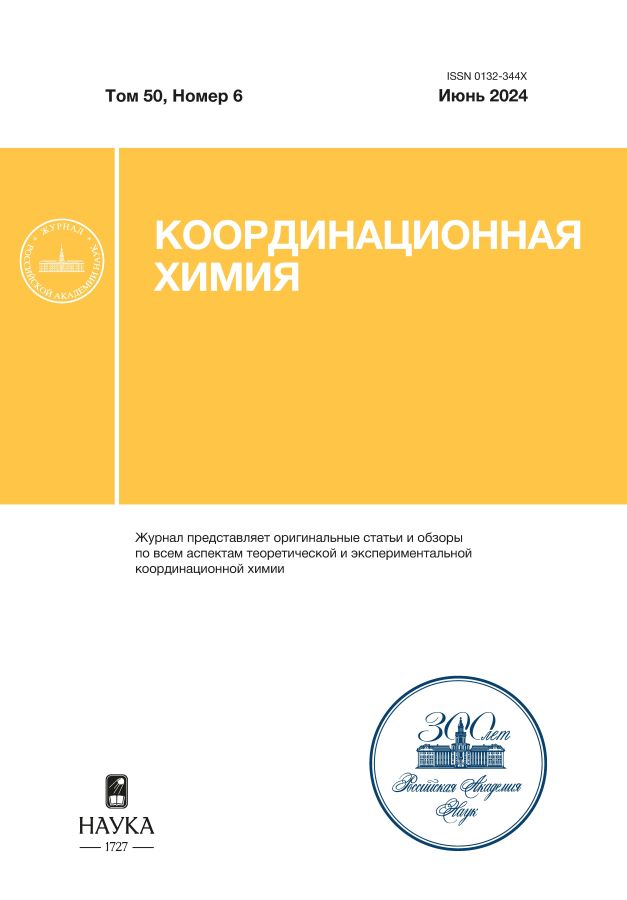Half-Sandwich Iminophosphonamide Rhodium Complexes as Highly Efficient Catalysts for Dehydrogenation of Dimethylamine-Borane
- Authors: Nekrasov R.I.1, Peganova T.A.1, Kal´sin A.M.1, Belkova N.V.1
-
Affiliations:
- Nesmeyanov Institute of Organoelement Compounds, Russian Academy of Sciences
- Issue: Vol 50, No 6 (2024)
- Pages: 394-401
- Section: Articles
- URL: https://rjonco.com/0132-344X/article/view/667594
- DOI: https://doi.org/10.31857/S0132344X24060053
- EDN: https://elibrary.ru/MVDOVM
- ID: 667594
Cite item
Abstract
The dehydrogenation of dimethylamine-borane (DMAB) catalyzed by the iminophosphonamide rhodium(III) complexes [Cp*RhCl{Ph2P(N–p-Tol)(NR)}] (Iа, R = p-Tol; Ib, R = Me) in situ formed fulvene [(η4-C5Me4CH2)Rh(NPN)] (IIa, IIb) and diene [(η4-C5Me5H)Rh(NPN)] (IIIa, IIIb) rhodium(I) derivatives is studied. Catalysts IIIa and IIIb turn out to be the most active and demonstrate a TOF activity of 110 (IIIа) and 540 h–1 (IIIb) at 40°С in toluene. The activity decreases significantly in more polar and coordinating THF. At the same time, the rate of DMAB dehydrogenation by complexes Iа and Ib is lower by 10–30 times, and fulvene complexes Iа and Ib are rapidly deactivated after the active initial period (<20% conversion). The kinetic studies show that the reaction has the first order with respect to the substrate and catalyst. The model 11В NMR experiments confirm that the reaction proceeds via the intermediate formation of a monomer Me2N=BH2, which rapidly dimerizes to (Me2N–BH2)2. The mechanism of DMAB dehydrogenation with the formation of unstable hydride intermediate [Cp*RhH{Ph2P(N–p-Tol)(NR)}] (IVa, IVb) is proposed on the basis of the preliminarily 31Р NMR results and published data.
Full Text
About the authors
R. I. Nekrasov
Nesmeyanov Institute of Organoelement Compounds, Russian Academy of Sciences
Email: nataliabelk@ineos.ac.ru
Russian Federation, Moscow
T. A. Peganova
Nesmeyanov Institute of Organoelement Compounds, Russian Academy of Sciences
Email: nataliabelk@ineos.ac.ru
Russian Federation, Moscow
A. M. Kal´sin
Nesmeyanov Institute of Organoelement Compounds, Russian Academy of Sciences
Email: nataliabelk@ineos.ac.ru
Russian Federation, Moscow
N. V. Belkova
Nesmeyanov Institute of Organoelement Compounds, Russian Academy of Sciences
Author for correspondence.
Email: nataliabelk@ineos.ac.ru
Russian Federation, Moscow
References
- Colebatch A.L., Weller A.S. // Chem. Eur. J. 2019. V. 25. P. 1379. https://doi.org/10.1002/chem.201804592
- Staubitz A., Robertson A.P.M., Manners I. // Chem. Rev. 2010. V. 110. p. 4079. https://doi.org/10.1021/cr100088b
- Du V.A., Jurca T., Whittell G.R., Manners I. // Dalton Trans. 2016. V. 45. P. 1055. https://doi.org/10.1039/C5DT03324A
- Resendiz-Lara D.A., Stubbs N.E., Arz M.I. et al. // Chem. Commun. 2017. V. 53. P. 11701.
- Kumar A., Daw P., Milstein D. et al. // Chem. Rev. 2022. V. 122. P. 385. https://doi.org/10.1021/acs.chemrev.1c00412
- Alig L., Fritz M., Schneider S. et al. // Chem. Rev. 2019. V. 119. P. 2681. https://doi.org/10.1021/acs.chemrev.8b00555
- Glüer A., Förster M., Celinski V. R. et al. // ACS Catal. 2015. V. 5. P. 7214. https://doi.org/10.1021/acscatal.5b02406
- Luconi L., Osipova E. S., Giambastiani G. et al. // Organometallics. 2018. V. 37. P. 3142. https://doi.org/10.1021/acs.organomet.8b00488
- Todisco., S., Luconi., L., Giambastiani., G et al. // Inorg. Chem. 2017. V. 56. P. 4296. https://doi.org/10.1021/acs.inorgchem.6b02673
- Titova. E.M., Osipova. E.S., Pavlov. A.A. et al. // ACS Catal. 2017. V. 7. P. 2325. https://doi.org/10.1021/acscatal.6b03207
- Sewell L.J., Huertos M.A., Dickinson M.E. et al. // Inorg. Chem. 2013. V. 52. P. 4509. https://doi.org/10.1021/ic302804d
- Johnson H.C., Leitao E.M., Whittell G.R. et al. // J. Am. Chem. Soc. 2014. V. 136. P. 9078. https://doi.org/10.1021/ja503335g
- Douglas T.M., Chaplin A.B., Weller A S. et al. // J. Am. Chem. Soc. 2009. V. 131. P. 15440. http://dx.doi.org/10.1021/ja906070r
- Kirkina V.A., Osipova E.S., Filippov O.A. et al. // Mendeleev Commun. 2020. V. 30. P. 276. https://doi.org/10.1016/j.mencom.2020.05.004
- Brodie C.N., Sotorrios L., Boyd T.M. et al. // ACS Catal. 2022, vol. 12. P. 13050. https://doi.org/10.1021/acscatal.2c03778
- Brodie C.N., Boyd T.M., Sotorríos L. et al. // J. Am. Chem. Soc. 2021. V. 143. P. 21010. https://doi.org/10.1021/jacs.1c10888
- White C., Yates A., Maitlis P.M. et al. // Inorg. Synth. 1992. V. 29. P. 228. https://doi.org/10.1002/9780470132609.ch53
- Nekrasov R.I., Peganova T.A., Fedyanin I.V. et al. // Inorg. Chem. 2022. V. 61. P. 16081. https://doi.org/10.1021/acs.inorgchem.2c02478
- Kruger C.R., Niederprum H. // Inorg. Synth. 1966. V. 8. P. 15.
- Pal S., Kusumoto S., Nozaki K. // Organometallics. 2018. V. 37. P. 906. https://doi.org/10.1021/acs.organomet.7b00889
- Sinopalnikova I.S., Peganova T.A., Belkova N.V. et al. // Eur. J. Inorg. Chem. 2018. V. 2018. P. 2285. https://doi.org/10.1002/ejic.20170134423
- Pal S., Iwasaki T., Nozaki K. // Dalton Trans. 2021, V. 50. P. 7938. https://doi.org/10.1039/D1DT01705E
- Dallanegra R., Robertson A.P.M., Chaplin A. B. et al. // Chem. Commun. 2011. V. 47. P. 3763. https://doi.org/10.1039/C0CC05460G
- Gulyaeva E.S., Osipova E.S., Kovalenko S.A. et al. // Chem. Sci. 2024. V. 15. P. 1409. https://doi.org/10.1039/D3SC05356C
Supplementary files

















